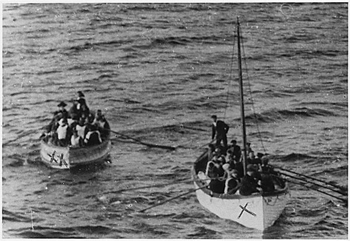|
Titanic
Lifeboats & The Titanic Disaster By The Numbers
Answer
to Name
This Famous Antique Game - August 2013

This photo of two of the lifeboats from the Titanic was correctly indentified by Scott and Carolyn Brown of Memories Flea An'Tique Mall in Prattville, Ala., Teresa P. Bland, Robert Bernier, and Ted Carlton of Utah.
The Titanic Disaster By The Numbers
2,226
Passengers and crew on board the ship when it struck an iceberg at 11:40 p.m. on April 14, 1912. On its maiden voyage, the Titanic was under capacity; she could have held 1,200+ more passengers.
3
Football fields in length, almost, the Titanic measured 882 feet 9 inches long.
37
Seconds, the time officers on the bridge had to maneuver the gigantic ship to avoid the iceberg
20
Lifeboats on the Titanic, 16 wooden and four collapsible. The White Star Line broke no maritime law in having only 20 lifeboats on board.1 The law required ships of 10,000 tons to have 16; it said nothing about larger ships. The Titanic weighed 45,000+ tons and actually carried more lifeboats than required by British maritime law.
1,523
People died in the disaster. Of those who survived, 75% (324) were women, 50% (56) were children, and 19% (323) were men. All 25 of the children in second class survived, but only 25 of 80 children survived who were in third class cabins. Six of seven children in first class survived.2
703
Survivors taken from lifeboats.3
1,178
People could have been saved if all lifeboats had been filled to capacity.
In that day, lifeboats were considered dangerous craft, particularly when lowering them down the side of a rolling ship in rough seas, which was most often the condition of the ocean when a ship was sinking. Lifeboats were only meant for ferrying people from a sinking ship to one that came to the rescue.
Also, ships were not expected to go down in only two hours and forty minutes as the Titanic did. Most stayed afloat for many hours, if not for a day or more, providing ample time for passengers to be transferred to a waiting ship via a limited number of lifeboats. With its watertight compartments, the Titanic was not expected to sink, or at least, it should have stayed afloat long enough to get the passengers off, as other sinking ships had done in the past.
337
Bodies recovered from the ocean by rescue ships. Of those, 119 were buried at sea; some being too damaged to preserve. Three ships were sent to pick up bodies (four passing ships also picked up a few bodies), and one, the Mackay-Bennett, carried morticians and embalming fluid because, according to law, only embalmed bodies could be brought to land. This was another reason why some were buried at sea—the morticians ran out of embalming fluid.4
$7,500,000
The cost to build the Titanic in 1912, or about $182 million today.
600
Tons of coal burned each day by the Titanic to power its engines and provide electricity and heat.5
4
Smokestacks on the Titanic, one of which was fake. All luxury liners had four stacks at the time so the designers stayed with tradition.
2
Dogs rescued.6
1
The number of Japanese on board. Desperate to see his wife and children again, Masabumi Hosono survived in a lifeboat, but on his return to Japan, he was vilified by the media and the people for not choosing an honorable death by going down with the ship. It was believed he dishonored Japan by not conforming to the western rule of “women and children first.” Hosono was ostracized, and he lived in shame throughout his life. He became a textbook example—he was actually listed in textbooks by name—of what happens when one brings shame upon the country or family.
When the movie Titanic aired in 1997, public opinion about Hosono shifted, and honor was restored to his descendants.7
--------------------------------------
1 Curiosity.discovery.com.
2 John R. Henderson,www.icyousee.org/titanic.html.
3 Ibid. The exact numbers of those on board, those who died, and those who survived vary somewhat among different sources due to errors and lack of records. Plus, others (such as company employees of the shipbuilder and musicians hired by an outside firm) may not have been exactly accounted for. In addition, some people died from exposure after they were rescued.
4 Nova Scotia Museum, http://museum.gov.ns.ca.
5 www.titanicandco.com/maiden.html.
6 About.com.
7 Margaret Mehl, “The Last of the Last,” www.encyclopedia-titanica.org.
|